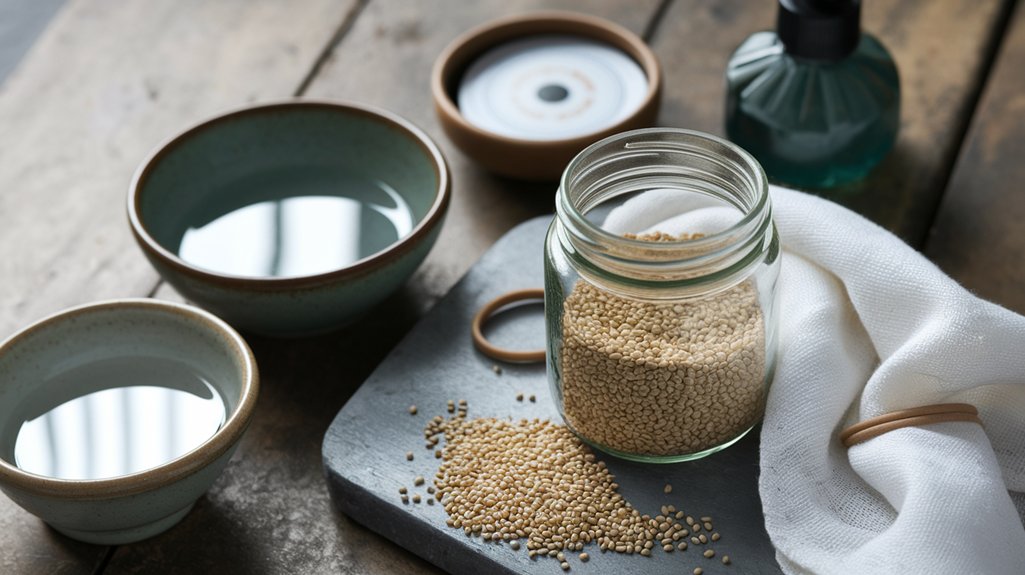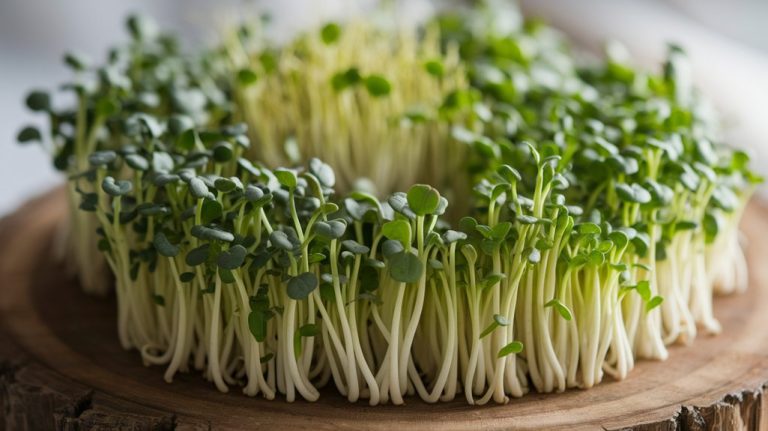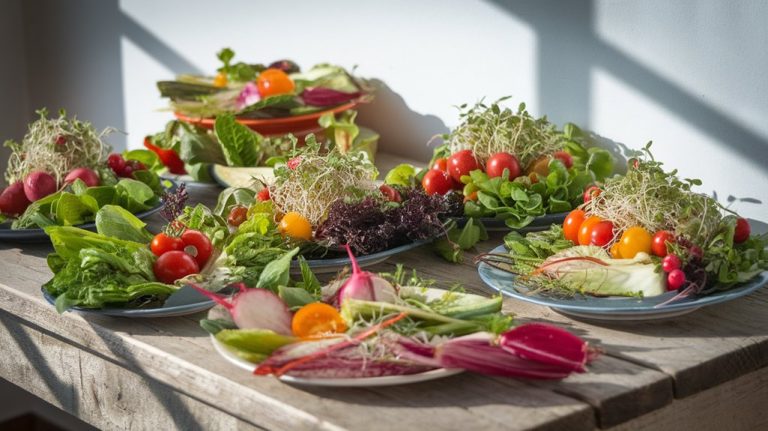How to Sprout Sesame
To sprout sesame seeds, start by rinsing them under cool water. Soak the seeds in a jar covered with water for about 6 hours, then drain and rinse again. Place the jar upside down at an angle to ensure air circulation. Rinse the seeds twice daily, and in about 3 to 5 days, you’ll see tiny sprouts emerging. It’s a simple process that adds a nutritious crunch to your meals. Let me share some delicious ways to use those sprouts!
Key Takeaways
- Rinse high-quality sesame seeds under cool water to remove debris before soaking.
- Soak the seeds in water for about 6 hours, then drain and rinse again.
- Place the jar upside down at an angle for proper air circulation and moisture control.
- Rinse the seeds twice daily until tiny sprouts appear, typically in 3 to 5 days.
- Expect seeds to sprout fully in about 4 to 7 days, depending on conditions.
What You Need to Get Started

Getting started with sprouting sesame seeds is easier than you might think! First, you’ll need high-quality sesame seeds—make sure they’re raw and unsalted.
You’ll also want a clean, wide-mouth jar or a sprouting tray, as these provide ample space for the seeds to expand. A breathable lid, like cheesecloth or a sprouting mesh, is essential for air circulation while keeping the seeds contained.
Don’t forget fresh, filtered water for rinsing and soaking. Lastly, a warm, dark spot in your kitchen will help your seeds sprout effectively.
With these simple materials at hand, you’re ready to embark on your sprouting adventure! Trust me, once you see those little sprouts, you’ll be hooked.
Step-by-Step Sprouting Process
Once you’ve gathered your materials, it’s time to dive into the sprouting process. First, I rinse the sesame seeds under cool water in a fine-mesh strainer.
Then, I place them in a jar and cover them with water, letting them soak for about 6 hours. After soaking, I drain the water and give the seeds a quick rinse again.
Next, I keep the jar upside down at an angle to allow air circulation and prevent excess moisture. I rinse the seeds twice a day, ensuring they stay moist but not soggy.
Within three to five days, I’ll notice tiny sprouts emerging. Once they reach about an inch long, they’re ready to enjoy in salads, sandwiches, or as a crunchy snack!
Tips for Successful Sprouting

While sprouting sesame seeds can be a rewarding process, there are a few tips that can help ensure success.
First, make sure to rinse your seeds thoroughly before soaking; this clears away any debris. Use a jar with a mesh lid or a sprouting tray to allow for proper airflow.
Keep the seeds in a dark, warm place during the initial sprouting phase, but remember to check on them daily. Water them gently to keep them moist but not soggy.
Patience is key; the seeds generally take about 4 to 7 days to sprout fully.
Lastly, once they’re ready, give them a final rinse and dry them briefly before using.
These simple tips will help you achieve vibrant, healthy sprouts!
Incorporating Sprouted Sesame Into Your Meals
After nurturing your sprouted sesame seeds, it’s time to enjoy their unique flavor and nutritional benefits in your meals.
I love finding creative ways to incorporate them into my dishes. Here are a few ideas to get you started:
- Salads: Toss sprouted sesame seeds into your favorite salad for a crunchy texture.
- Smoothies: Blend them into your morning smoothie for an added nutrient boost.
- Stir-Fries: Sprinkle them over stir-fried vegetables or tofu for extra flavor.
- Baked Goods: Mix them into bread or muffin batter for a nutty twist.
Health Benefits of Sprouted Sesame Seeds

Sprouted sesame seeds are a powerhouse of nutrition, and I’ve found they can significantly enhance my well-being. These tiny seeds pack a big punch; they’re rich in essential fatty acids, protein, and fiber.
I love that they’re loaded with antioxidants, which help combat oxidative stress in my body. The magnesium in sprouted sesame can also support my heart health and regulate blood pressure.
Plus, they contain calcium and iron, making them a fantastic addition to my diet, especially for bone health. I’ve noticed improved digestion and energy levels since incorporating them into my meals.
Sprouted sesame seeds truly offer a unique blend of health benefits that can support a balanced lifestyle. Give them a try, and you might feel the difference too!
Frequently Asked Questions
Conclusion
Now that you know how to sprout sesame seeds, I encourage you to give it a try! The process is simple, and the rewards are delicious and nutritious. By incorporating sprouted sesame into your meals, you can enhance flavors and boost your health. Plus, it’s a fun way to experiment in the kitchen. I can’t wait for you to experience the benefits and joy of sprouting sesame seeds for yourself! Happy sprouting!







